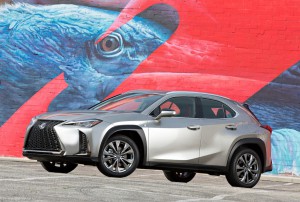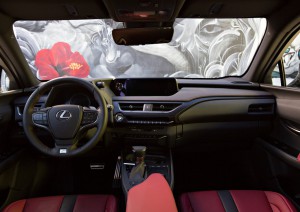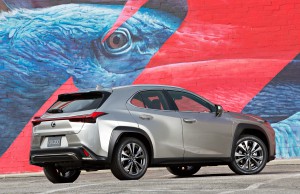
The new Lexus UX is being billed as an "urban explorer" because of its utility and ability for city adventures.
Americans are often seen as thinking that bigger is always better. However, the hottest new sellers in the U.S. are small, luxury utes, which could be seen as “bigger” in terms of style, technology and performance, and one might say that is always better.
The new Lexus UX, which is making its North American debut at the New York International Auto show, certainly lives up to that bill. The new “urban explorer” of utility vehicles, the UX fills a gap in the luxury brand’s line-up at the right time.
“The first-ever Lexus UX is designed for the modern urban explorer seeking a fresh, contemporary and dynamic take on luxury driving,” said Chika Kako, executive vice president of Lexus International and chief engineer of the UX.
“We designed the UX to appeal to buyers in their 30s who seek not only what is new and exciting, but what is also relevant to their lifestyles.”
(Lexus turns “urban explorer” with new UX debut in Geneva. For more, Click Here.)
The UX, which made its debut Geneva, is the first vehicle to uses the brand’s new GA-C, or Global Architecture – Compact, platform. The new base is extremely rigid and has a low center of gravity improving the ride and handling of the new UX.
Having the ability to move in-and-out of spaces quickly and authoritatively while being easy to park makes it ideal for a city commuter, hence the “urban” crossover.
The 2019 Lexus UX will be available in two versions: a gasoline-powered model and a hybrid. The UX 200 introduces a new 2.0-liter, four-cylinder engine paired with a new Direct-Shift continuously variable transmission (CVT).
The UX 250h pairs the same 2.0-liter gas engine with a new fourth generation hybrid-drive system. New technology that networks with navigation allows the UX 250h to proactively optimize hybrid operation by learning, and adapting to the driver’s routes and driving habits.
Those driving habits can be improved with a vehicle whose proportions allow for easy maneuverability. The UX boasts a best-in-segment 34-foot turning circle. A 103.9-in. wheelbase contributes to a smooth, stable ride and cabin roominess, while the 177-inch length lets the Lexus UX easily slip into convenient “compact only” parking spaces.

The upscale, two-tone leather interior of the new UX is matched only by the soft-touch finishes as well as technology.
The new UX can also be equipped with the brand’s F Sport suspension system and can be combined with a UX-tailored version of the high-response Adaptive Variable Suspension system that increases damping force to minimize roll when cornering or changing lanes and reduces damping force in straight line driving to preserve ride quality. When AVS is fitted, it is linked to the Sport S+ mode in the vehicle’s Drive Mode Select system.
(Click Here for more about Lexus downsizing with new UX crossover.)
The new model borrows is exterior styling from the new RX and the brand’s new styling directive, which is to be less staid and more aggressive. Featuring the newest iteration of the spindle grille, the vehicle’s front and rear fenders are flared to give it a dramatic presence.
The aforementioned spindle grille uses a new block-shape mesh pattern with individual elements that gradually change in shape as they radiate out from the central Lexus emblem, almost providing a 3-D effect, according to the maker.
Entering and exiting the UX is made easier through optimal placing of the hip-point and unique shaping of the seat cushion. The “human-centered” approach continues behind the steering wheel. The instrument panel’s low design and slim A-pillar moldings improve visibility, giving the driver a “commanding view” of the road, which is expected from a crossover, but a driving position more like that in a hatchback.
A “seat-in-control” concept focuses operation of all key vehicle functions and technology around the driver’s side of the cabin. There’s plenty of technology in the Lexus UX, and here again, the human-centered design approach makes it all easily accessible. One example is the integration of audio switches into a palm rest on the center console.
Another is that each of the UX’s air vents uses a new single-knob control for airflow direction and volume while the vents themselves are illuminated using a new wireless system. By combining the two functions in a single control, the vents could be made larger, improving their effectiveness. Each control’s LED light source is wirelessly powered using electromagnetic resonance between two coils vibrating at the same frequency.
(For more about Lexus setting industry pace in long-term dependability, Click Here.)
The UX 200 and UX 250h will start production this fall and go on sale in the U.S. in December. Pricing will be announced closer to the on-sale date.


Ford is likely to take offence to the name.
Although Lexus will never use an actual name on their vehicle, Ford should be a little miffed. It’s not like when Infiniti and Audi tried to claim rights to the letter Q.